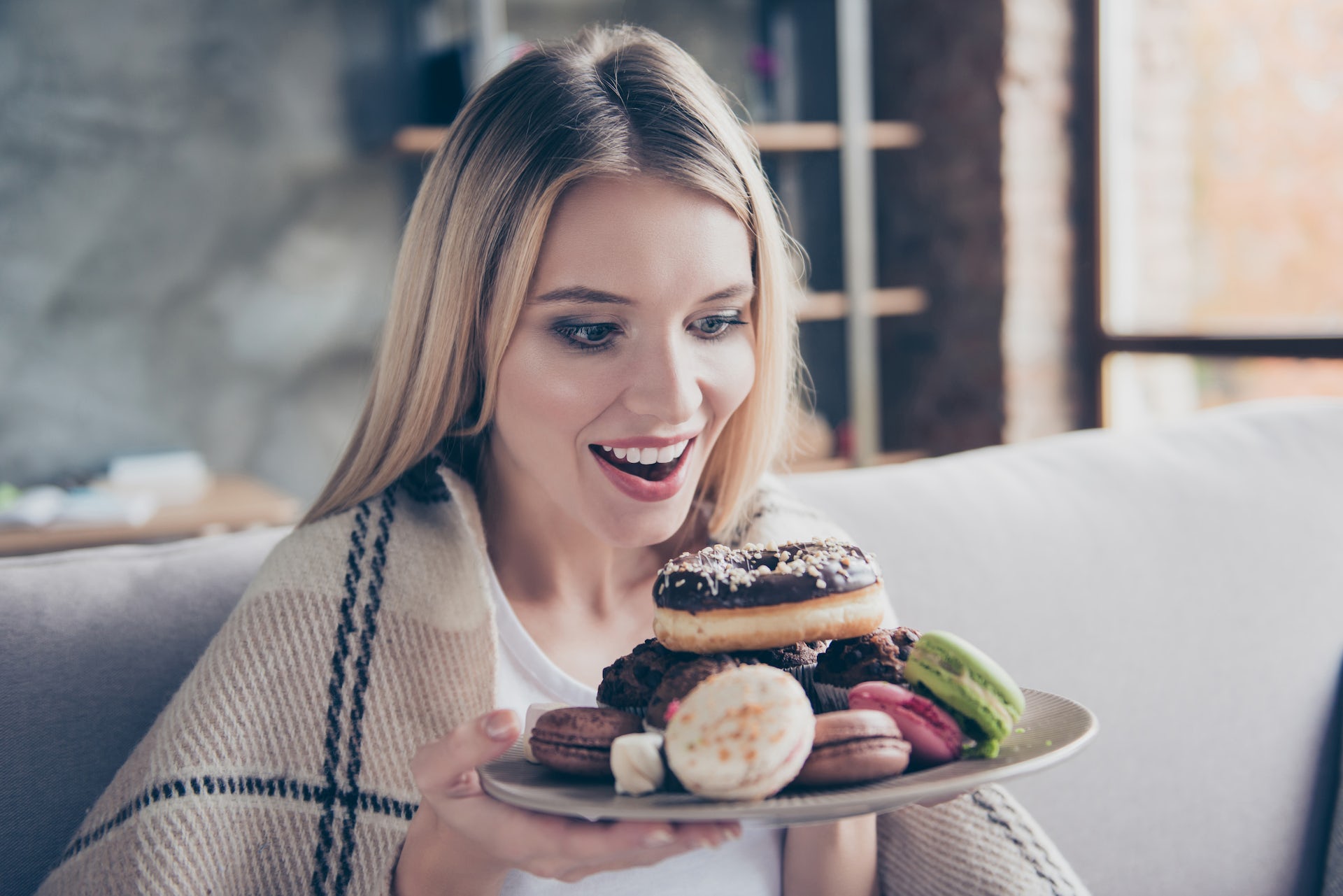Cravings are powerful, intense desires for specific foods or substances. These desires can be so compelling that they may feel nearly impossible to resist. While cravings often revolve around foods, they can also extend to non-food items in some cases, a condition known as pica.
Cravings typically center on particular tastes, textures, or flavors, and they can vary widely among individuals. Some common examples include a strong hankering for chocolate, salty snacks, sugary treats, or even specific comfort foods from one’s cultural or childhood background.
1.Why Do I Have Food Cravings?
Cravings are a fascinating interplay of biology, psychology, and environment. Hormones like ghrelin, which signals hunger, can trigger cravings. Emotional factors, stress, and even societal influences, like advertisements or social gatherings, can also play a role. Cravings are your body’s way of communicating its needs or responding to cues, and understanding these triggers empowers you to manage them effectively.
2.How to Stop Sugar Cravings?
To stop sugar cravings, you can take several steps:
- Reduce Added Sugars: Gradually decrease the consumption of foods and drinks with added sugars, such as sugary snacks, sodas, and desserts.
- Opt for Healthier Alternatives: When a sugar craving hits, choose healthier alternatives like fresh fruit, Greek yogurt with honey, or nuts.
- Balanced Meals: Eat balanced meals with a combination of carbohydrates, proteins, and healthy fats to help stabilize blood sugar levels and minimize sugar cravings.
- Stay Hydrated: Dehydration can sometimes mimic hunger. Drinking water throughout the day can reduce the intensity of cravings.
- Mindful Eating: Pay attention to your body’s hunger and fullness cues. Sometimes, cravings are psychological rather than physical.
- Chew Gum: Chewing sugar-free gum can help satisfy the oral fixation associated with cravings.
Remember that overcoming sugar cravings may take time and persistence, but with these strategies, you can gradually reduce your reliance on sugary foods.
3.What Causes Cravings During Pregnancy?
Cravings during pregnancy can be influenced by a combination of hormonal changes and various factors:
- Hormonal Fluctuations: Pregnancy leads to significant hormonal shifts, which can affect taste preferences and cravings.
- Nutrient Needs: Sometimes, cravings are your body’s way of signaling specific nutrient needs. For example, a craving for citrus fruits might indicate a need for vitamin C.
- Cultural and Social Factors: Cravings can also be influenced by cultural or societal factors. Family traditions, pregnancy myths, or even popular media can play a role in shaping pregnancy cravings.
- Emotional Factors: Emotional changes during pregnancy, such as stress, anxiety, or mood swings, can contribute to cravings as a way of coping with emotions.
It’s essential for pregnant individuals to embrace cravings in moderation while maintaining a balanced and nutritious diet to support both their health and the developing baby. Consulting with a healthcare provider or a registered dietitian can provide guidance on managing pregnancy cravings effectively.
4.Are Cravings Related to Nutrient Deficiencies?
Cravings can sometimes be related to nutrient deficiencies, but it’s essential to understand that they are not always indicative of a deficiency. While your body may crave specific foods when it’s lacking certain nutrients, cravings are influenced by various factors. Here’s how they can be related to nutrient deficiencies:
- Specific Cravings: If you consistently crave a particular type of food, like red meat or leafy greens, it could be a signal that your body is deficient in a nutrient commonly found in that food. For instance, a craving for red meat might suggest an iron deficiency.
- General Cravings: Generalized cravings for a wide range of foods may not necessarily point to a specific nutrient deficiency. These cravings can be influenced by emotional, hormonal, or environmental factors.
While it’s wise to pay attention to persistent and specific cravings, it’s essential to consult with a healthcare provider or registered dietitian to assess your nutritional status and address any potential deficiencies. They can recommend appropriate dietary changes or supplements to meet your nutrient needs effectively.
5.How to Curb Late-Night Cravings?
Curbing late-night cravings can be challenging, but these strategies can help:
- Establish a Sleep Routine: Aim for a consistent sleep schedule to regulate your body’s internal clock and reduce late-night snacking.
- Avoid Large Meals Before Bed: Consuming heavy, large meals close to bedtime can disrupt sleep and trigger cravings. Finish your last meal at least 2-3 hours before sleep.
- Opt for Light Snacks: If you’re genuinely hungry, choose light and nutritious snacks like yogurt, a piece of fruit, or a small serving of whole-grain cereal with milk.
- Stay Hydrated: Sometimes, thirst can be mistaken for hunger. Drink a glass of water before reaching for a snack to ensure you’re not dehydrated.
- Practice Mindful Eating: Slow down and savor your snacks. Mindful eating can help you become more aware of your body’s hunger and fullness cues.
- Limit Screen Time: Avoid watching TV or using electronic devices while eating, as distractions can lead to overeating.
- Prep Healthy Snacks: Keep healthier options readily available. Pre-cut fruits and veggies, nuts, or low-fat popcorn can be convenient choices.
- Identify Triggers: Pay attention to what triggers your late-night cravings. Stress, boredom, or emotional factors may play a role. Find alternative ways to address these triggers, such as relaxation techniques or engaging in a calming activity.
- Brush Your Teeth: Brushing your teeth right after dinner can signal to your brain that eating is over for the day.
Remember that occasional late-night snacks are normal, but consistently practicing these strategies can help reduce their frequency and support better sleep and overall health.
6.What Are the Psychological Reasons Behind Cravings?
Cravings often have deep psychological roots, and several psychological reasons can explain why we experience them:
- Emotional Triggers: Stress, anxiety, sadness, and boredom can trigger cravings as a way to cope with emotions. Food can provide comfort and distraction from negative feelings.
- Reward System: The brain’s reward system can play a role in cravings. When we consume certain foods, particularly those high in sugar and fat, the brain releases dopamine, a feel-good neurotransmitter. Over time, this creates a positive association, leading to cravings for those foods.
- Habitual Cravings: Repeatedly consuming specific foods at certain times or in particular situations can lead to habitual cravings. For example, if you regularly have dessert after dinner, your body may come to expect it.
- Environmental Cues: Environmental factors like advertisements, the sight or smell of food, or being in a familiar setting can trigger cravings. These cues remind the brain of past enjoyable experiences associated with specific foods.
- Social and Cultural Influences: Social gatherings, celebrations, or cultural traditions often involve specific foods. Cravings can be influenced by the desire to fit in or to connect with others.
Understanding the psychological reasons behind cravings is essential for managing them effectively. Techniques like mindfulness, stress management, and finding alternative ways to cope with emotions can help address these psychological triggers and reduce the intensity of cravings.
7.How to Overcome Cravings for Unhealthy Foods?
Overcoming cravings for unhealthy foods requires a multi-faceted approach. Here are strategies to help you conquer those tempting urges:
- Substitute with Healthier Options: Replace unhealthy snacks with nutritious alternatives. For example, opt for air-popped popcorn instead of potato chips or Greek yogurt with berries instead of sugary desserts.
- Plan Your Meals: Create a meal plan that includes balanced, satisfying meals and snacks throughout the day. This can help prevent extreme hunger and subsequent unhealthy cravings.
- Mindful Eating: Pay attention to your body’s hunger and fullness cues. Before reaching for a craving, ask yourself if you’re truly hungry or if it’s a psychological craving. Mindful eating can help you make more conscious choices.
- Stay Hydrated: Sometimes, thirst is mistaken for hunger. Drink water regularly throughout the day to ensure you’re adequately hydrated.
- Practice Portion Control: If you decide to indulge in an unhealthy craving, do so in moderation. Portion control allows you to satisfy the craving without overindulging.
- Remove Temptations: Keep unhealthy foods out of your immediate environment. If they’re not readily available, you’re less likely to succumb to cravings.
- Get Support: Share your goals with a friend or family member who can offer encouragement and help you stay accountable.
- Identify Triggers: Pay attention to what triggers your unhealthy cravings. Stress, boredom, or specific situations may be the culprits. Finding alternative ways to cope with these triggers can reduce cravings.
- Practice Self-Compassion: Don’t be too hard on yourself if you occasionally give in to cravings. It’s normal to indulge from time to time. Focus on progress rather than perfection.
- Seek Professional Help: If you find it challenging to manage cravings on your own, consider consulting with a registered dietitian, therapist, or counselor who specializes in nutrition and behavioral strategies.
Remember that overcoming cravings is a gradual process, and setbacks may occur. Consistency and patience are key to successfully shifting your eating habits toward healthier choices.
8.Are There Strategies to Reduce Cravings for Junk Food?
Absolutely, there are effective strategies to reduce cravings for junk food:
- Mindful Eating: Pay attention to your eating experience. Savor each bite, chew slowly, and fully appreciate the flavors and textures of your food. Mindful eating can help you become more attuned to your body’s hunger and fullness cues, reducing the urge to overindulge in junk food.
- Balanced Meals: Consume well-balanced meals that include a mix of carbohydrates, protein, and healthy fats. This can help stabilize blood sugar levels and reduce the likelihood of sudden cravings.
- Regular Meal Times: Stick to a regular meal schedule. Skipping meals or going too long between meals can lead to excessive hunger, making junk food cravings more difficult to resist.
- Hydration: Ensure you stay adequately hydrated throughout the day. Dehydration can sometimes be mistaken for hunger, leading to cravings.
- Healthy Snacking: Plan for healthy snacks between meals. Opt for nutrient-rich options like fresh fruits, vegetables with hummus, or Greek yogurt with berries to keep your energy levels steady.
- Keep Junk Food Out of Sight: Avoid having junk food readily accessible in your home or workspace. When it’s out of sight, you’re less likely to succumb to cravings.
- Practice Stress Management: Find healthy ways to cope with stress, such as meditation, deep breathing exercises, or physical activity. Stress can trigger cravings for comfort foods.
- Sleep Well: Prioritize getting enough quality sleep. Sleep deprivation can affect hormones that regulate appetite and cravings.
- Portion Control: If you decide to indulge in junk food occasionally, practice portion control. Enjoy a small serving rather than consuming the entire package.
- Seek Support: Share your goals with friends or family members who can provide encouragement and help you stay accountable.
- Replace Cravings with Healthier Options: When a junk food craving strikes, try to replace it with a healthier alternative. For instance, if you’re craving chips, opt for baked whole-grain crackers or veggie sticks with salsa.
- Understand Triggers: Identify the situations, emotions, or activities that trigger your cravings. Finding alternative ways to address these triggers can reduce the frequency of cravings.
Remember that reducing cravings for junk food is a gradual process, and occasional indulgences are perfectly normal. Be patient with yourself and focus on making long-term, sustainable changes to your eating habits.
9.Are There Strategies to Reduce Cravings for Junk Food?
Certainly, there are effective strategies to reduce cravings for junk food:
- Mindful Eating: Pay close attention to what you eat and savor each bite. Mindful eating can help you become more aware of your cravings and make conscious choices.
- Plan Your Meals: Create a meal plan that includes balanced, satisfying meals and snacks. Regular, well-balanced meals can help prevent extreme hunger and reduce the urge to reach for junk food.
- Hydrate: Ensure you drink enough water throughout the day. Sometimes, thirst is mistaken for hunger, leading to unnecessary cravings.
- Healthy Snacking: Keep healthy snack options readily available, such as fresh fruits, vegetables with hummus, or mixed nuts. These can help satisfy your hunger and reduce the temptation to snack on junk food.
- Portion Control: If you decide to indulge in junk food, practice portion control. Rather than eating an entire bag of chips, enjoy a small, measured portion.
- Remove Temptations: Keep junk food out of your home or workspace. If it’s not readily accessible, you’re less likely to give in to cravings.
- Stress Management: Find healthy ways to cope with stress, such as exercise, deep breathing, meditation, or hobbies you enjoy. Stress can trigger cravings for comfort foods.
- Sleep Well: Prioritize getting enough quality sleep. Sleep deprivation can disrupt hormones that regulate appetite and cravings.
- Understand Your Triggers: Identify the situations or emotions that trigger your cravings for junk food. Once you’re aware of these triggers, you can develop healthier coping mechanisms.
- Seek Support: Share your goals with friends or family members who can offer encouragement and help you stay accountable.
- Replace with Healthier Options: When you experience a craving for junk food, try to replace it with a healthier alternative. For example, choose whole-grain crackers with hummus instead of potato chips.
- Practice Self-Compassion: Don’t be too hard on yourself if you occasionally give in to cravings. It’s normal to indulge from time to time. Focus on your overall progress rather than occasional setbacks.
Remember that reducing cravings for junk food is a gradual process, and consistency is key. By implementing these strategies and making healthier choices over time, you can successfully manage and reduce your cravings for unhealthy foods.
10.What Are the Best Foods to Satisfy Chocolate Cravings?
If you’re craving chocolate, there are healthier options to satisfy your sweet tooth without overindulging in sugar and fat. Here are some of the best foods to satisfy chocolate cravings:
- Dark Chocolate: Choose dark chocolate with a high cocoa content (70% or higher). It offers the rich chocolate flavor you crave with less sugar.
- Cocoa-Based Smoothie: Blend unsweetened cocoa powder with a banana, Greek yogurt, and a splash of milk for a creamy, chocolate-flavored smoothie.
- Chocolate-Covered Fruits: Dip strawberries, banana slices, or apple wedges in melted dark chocolate for a delicious and nutritious treat.
- Chocolate-Dusted Nuts: Coat almonds or walnuts with a light dusting of unsweetened cocoa powder for a crunchy, satisfying snack.
- Chocolate Protein Shake: Mix chocolate-flavored protein powder with water or milk for a protein-packed chocolate fix.
- Chocolate Oatmeal: Stir unsweetened cocoa powder into your morning oatmeal, and sweeten it with honey or a touch of maple syrup.
- Chia Pudding: Make a chocolate chia pudding by mixing chia seeds, unsweetened cocoa powder, milk (dairy or non-dairy), and a natural sweetener like agave syrup.
- Chocolate-Covered Rice Cakes: Spread a thin layer of almond or peanut butter on a rice cake and drizzle it with melted dark chocolate.
- Chocolate Banana Ice Cream: Freeze ripe bananas, then blend them with cocoa powder for a creamy and healthy chocolate “ice cream.”
These options offer a satisfying chocolate flavor while providing nutrients and fiber, making them better choices than indulging in high-sugar, high-fat chocolate bars or candies. Remember to enjoy chocolate treats in moderation as part of a balanced diet.
11.Can Cravings Be a Sign of an Underlying Health Issue?
Occasional cravings are a normal part of life, but persistent or unusual cravings can sometimes be a sign of underlying health issues. Here’s when cravings might be a potential indicator of a health concern:
- Specific Nutrient Deficiencies: Cravings for certain foods, especially those rich in specific nutrients, can signal deficiencies. For example, a strong craving for ice might be associated with iron deficiency anemia, while a craving for citrus fruits could indicate a need for vitamin C.
- Hormonal Imbalances: Some hormonal imbalances can influence cravings. Conditions like polycystic ovary syndrome (PCOS) and thyroid disorders can affect appetite and cravings.
- Gastrointestinal Issues: Conditions like celiac disease or irritable bowel syndrome (IBS) can lead to cravings for specific foods, often related to the body’s attempt to alleviate digestive discomfort.
- Pregnancy: Pregnancy can bring about unique and intense cravings due to hormonal changes and nutritional needs. While most pregnancy cravings are harmless, it’s essential to ensure that dietary choices remain balanced for both the mother and baby’s health.
- Psychological Factors: Emotional stress, anxiety, or mood disorders can contribute to cravings as a way of coping with emotions. Addressing these psychological factors through therapy or counseling may help manage cravings.
If you experience persistent or concerning cravings, especially if they are accompanied by other symptoms or changes in health, it’s advisable to consult with a healthcare provider. They can perform relevant tests, assess your overall health, and provide guidance on managing cravings in the context of potential underlying health issues.
12. How to Differentiate Between Hunger and Cravings?
Differentiating between hunger and cravings can be challenging, but it’s crucial for making mindful eating choices. Here’s how you can distinguish between the two:
Hunger:
- Gradual Onset: Hunger typically develops gradually over time. It may start as a mild discomfort and grow in intensity.
- Physical Signs: True hunger is often accompanied by physical sensations like a growling stomach, feelings of emptiness, or a slight drop in energy.
- Open to Various Foods: When you’re genuinely hungry, a variety of foods will sound appealing, and you’re more likely to make balanced meal choices.
- Satisfied by Nutritious Foods: Eating a balanced meal that includes proteins, carbohydrates, and fats will satisfy hunger, and the desire to eat diminishes.
Cravings:
- Sudden Onset: Cravings can strike suddenly and feel like an intense desire for a specific food.
- Specific Food: Cravings are usually for a particular food, often something indulgent or high in sugar, salt, or fat.
- Psychological: Cravings are often driven by psychological factors, such as emotions or past associations with certain foods.
- Not Satisfied by Substitutes: Trying to satisfy a craving with a different, healthier food may not work. You’ll still crave the specific item you desire.
To make healthier food choices and maintain balanced eating habits, it’s important to listen to your body and practice mindful eating. When you recognize that you’re experiencing a craving rather than genuine hunger, you can employ strategies like distraction, finding alternative activities, or choosing a healthier substitute to manage the craving effectively.
13. What Are Cravings for Non-Food Items (Pica) and Why Do They Occur?
Cravings for non-food items, a condition known as “Pica,” can be puzzling and potentially harmful. Here’s an explanation of Pica and why it occurs:
What is Pica?
Pica is a disorder characterized by an intense and persistent craving to eat non-food substances or engage in non-nutritive, non-food behaviors. These non-food items can vary widely and may include things like dirt, clay, chalk, paper, ice, soap, cloth, or even hair.
Why Does Pica Occur?
Pica can be influenced by several factors:
- Nutritional Deficiencies: In some cases, Pica can be a response to nutrient deficiencies, particularly minerals like iron or zinc. The body craves non-food items in an attempt to obtain these missing nutrients.
- Psychological Factors: Pica can also have psychological causes. Stress, anxiety, obsessive-compulsive disorder (OCD), or other mental health conditions may trigger Pica behaviors as a way to cope with emotions.
- Cultural or Social Influence: Cultural or social factors can play a role in Pica. Some cultures have traditions or rituals involving the consumption of non-food items, while others may consider it a form of self-soothing.
- Pregnancy: Pica cravings can sometimes occur during pregnancy, likely due to hormonal changes and nutrient needs.
- Developmental Disorders: Individuals with developmental disorders, such as autism spectrum disorder, may be more prone to Pica behaviors.
Pica can have serious health consequences, including digestive problems, nutritional deficiencies, and the risk of ingesting harmful or toxic substances. If you or someone you know is experiencing Pica, it’s essential to seek medical and psychological evaluation and treatment to address the underlying causes and prevent potential health risks.













